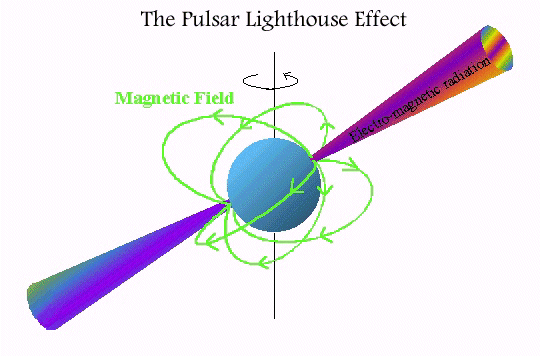Pulsars
As the name implies, a pulsar emits radio pulses at regular intervals.
The duration of the pulse itself is very short, of order microseconds.
The interval between pulses is called the pulse period . Typical
pulse periods range from 0.25 to 2 seconds; pulsars with periods in the
range of 1 to 10 milliseconds are called
millisecond pulsars.
Pulsars are rapidly rotating highly magnetized
neutron stars.
Highly energetic electrons spiraling in the magnetic field emit
radio beams along the magnetic axis. The
pulses are detected when the radio beam sweeps through
the direction to the earth, much like a lighthouse beacon.

The neutron star acts like an enormous magnet, with the magnetic poles
tipped at an angle to the axis of rotation. Like the Earth, the pulsar
is surrounded by a magnetosphere, a region
in which electrons and other particles are accelerated by the magnetic field.
However, the magnetic field of the pulsar is much stronger than the Earth's
and the electrons move at velocities close to the speed of light, emitting
synchrotron radiation in a narrow beam along the direction
of the magnetic poles.
If the radio beam sweeps past the Earth as the star rotates,
we detect a radio pulsar. Some neutron stars may never be seen as pulsars,
because their beams do not sweep through the direction to Earth.
